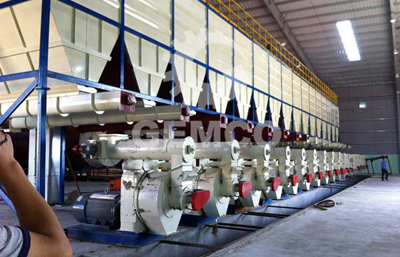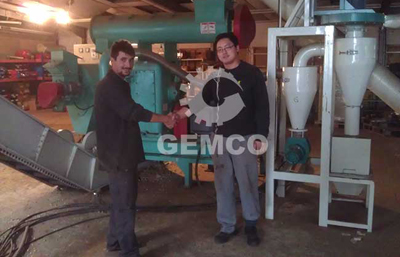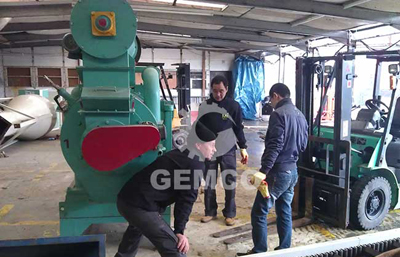Biomass gasification power generation technology and problems
Principle of biomass gasification power generation
Briefly speaking, biomass gasification is to turn biomass into combustible gas, and use the gas to drive the power generator.
Biomass gasification power generation is the most effective and cleanest way to make use of biomass energy. It can solve the scattered distribution of biomass resources, and achieve high production and low pollution in compact equipment.
Biomass gasification power generation can be divided into 3 steps.
- Gasification: The gasifier transform solid biomass into gas fuel.
- Gas purification: The biogas contain some impurities like ash, coke and tar, which need to be removed by a purification system.
- Gas power generation: The biogas drive the gas turbine or internal combustor to generate power. To improve the efficiency, it is often added with waste heat boiler and steam turbine.
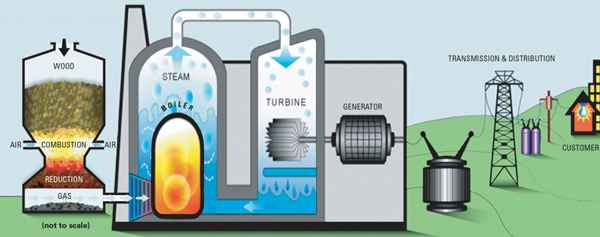
Characteristics of biomass gasification power generation
The technology is flexible
Biomass gasification can adopt gas turbine, internal combustor, even combining waste heat boiler and steam power generation system. It can choose different equipment according to the scale to achieve the best generation efficiency. High flexibility ensure its adaption to the scattered distribution of biomass resources.
Clean and environmentally friendly
Biomass is a renewable energy. It is the chemical form of solar power deposited in plants. Application of biomass energy can reduce the emission of CO2, SO2 and other noxious gas. As the gasification temperature is low (about 700-900e), the NOx emission is low.
Simple and Economical
The flexibility of biomass gasification ensure the economic benefit in small scale production. Compared with other new energy power generation, biomass gasification has simpler process, so the equipment and technology investment is smaller. In fact, biomass gasification power generation is the most economical renewable energy technology.
Types of biomass gasification power generation
According to the power generation process, biomass gasification can be classified into internal combustion engine power generation, gas turbine power generation, combined gas-steam cycle power generation.
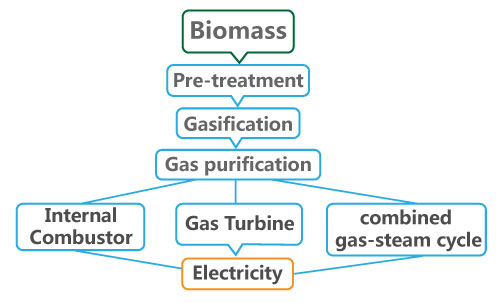
Biomass Internal combustor power generation
This biomass gasification technology features compact equipment, simple system, and low requirement on the gas quality. It applies to low-calorific gas and oil.
As biogas have low calorific value and high impurity content, it has additional requirement on the power generation equipment. For internal combustion engine, it have to solve these technique problems.
- Low calorific value: Biogas has lower heat value than oil and natural gas. To ensure the same output, the feeding and burning system, and the compression ratio of the internal combustor must be transformed.
- High hydrogen content: The Hydrogen content in biogas are risky. Hydrogen burns faster than other biogas, which may cause detonation in the combustor. According to experiments, if the H2 content is higher than 18%, it is easy to cause detonation. So it is required the Hydrogen content in biogas less than 15%.
- Impurities in biogas: Biogas contains some tar and ash, even after it has been purified. These impurities would cause failure to the ignition system. The carbon deposit would aggravate the equipment abrasion and even cause scratch. So the wearing of combustion engines adopting biogas wear more serious than other fuels.
- High smoke temperature and low efficiency: Low-calorie fuels burns slower, so the smoke discharge temperature is higher in internal combustion engine. These will affect the heating efficiency and accelerate the aging of the equipment.
For these problems, biogas internal combustion units are not widely used. Some power plants adopt dual-fuel type unit for biomass and oil, or upgrade the natural gas generating set to adapt to biogas. But the cost is high. To develop economical and reliable biogas internal combustion units is the main task currently.
Biomass gas turbine power generation
Gas turbine is one of the most common power generation equipment. This technology is mature and used mainly in aviation. Gas turbine usually adopt oil, natural gas as fuel. The power generation scale is usually larger than 3MW, and even up to hundreds of MW.
Biogas turbine power generation has the following problems:
- Biogas is low-calorie fuel. Its burning temperature is lower than natural gas. Large volume makes it hard to compress and lower its power generation efficiency.
- Biogas has corrosion ingredients like alkali metal, which set high requirement on the rotating speed and materials of the gas turbine.
- According to research, alkali metal and sulfide has huge impact on the burning. Although biomass have low sulfur content, 0.1% sulfur in it would generate 100ppm SOx.
- As biomass are scattered distributed, so the power generation scale is limited. But small-scale gas turbines have high unit cost and low efficiency, so they are not widely applied.
Gas turbine has high requirement on the purity of fuel. Generally purified biogas can’t meet the standard. To make full use of biogas, the gas turbine and purification system need to be upgraded.

Combined Gas-steam cycle power generation
In gas internal combustor and gas turbine, the waste gas temperature is 500-600e, and the gas temperature in the gasifier outlet is as high as 700-800e. They still contains large quantities of energy. We can equip them with heat recovery boilers and superheater to generate steam, and recycle the steam to generate power. This biomass gasification power generation technology adopt the same working principle as IGCC for coals, so it is also called BPIGCC.
Traditional BPIGCC technology includes biomass gasification, biogas purification, gas turbine power generation, and steam turbine power generation. With normal pressure gasification and low-temperature purification, the power generation efficiency is lower than 35%. By adopting high-pressure biomass gasification technology and high-temperature purification technology, they can increase the efficiency to 40% .
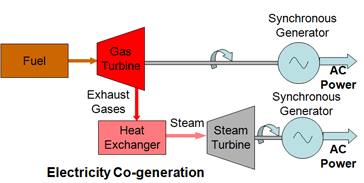
Due to the scattered distribution of steam turbine, the power generation scale of biomass gasification plant is lower than 100MW. The BPIGCC demonstration projects are usually around 10MW. Most BPGICC projects has the heat efficiency over 35%, 2 times that of biogas internal combustor power generator, but is still lower than the IGCC for coals. Theoretically, adding steam recycling system is an effective way to increase the power generation efficiency, as long as you’ve controlled the budget of heat recovery system.
Conclusion
To sum up, biomass gasification power generation has 2 basic systems, one is with internal combustor, the other is with gas turbine. To increase the power generation efficiency, they are equiped with heat recovery system and steam turbine to realize combined gas and steam recycle power generation.
It is well acknowledged that internal combustor is suitable for the power plants of under 10MW, while gas turbine is suitable for 10-20MW power system. For the power plant over 20MV, they need adopt high-pressure gasification technology.
Most gas turbine power generation system are equipped with steam recycling system, which can increase the efficiency significantly. For small-scale power generation, gas internal combustor has wider applications owing to small size, high efficiency, easy operation, and low requirement on the biogas quality.
We receive enquiries in English, Español (Spanish), Русский язык (Russian), Français (French) and العربية (Arabic). Our professional team will reply to you within one business day. Please feel free to contact us!
